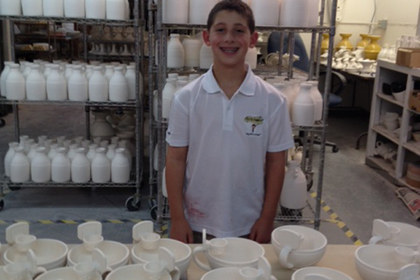Max Ash is the creator of a line of sports mugs that encourages consumers to play with their food. The hardest part in founding his company was manufacturing.
Max Ash made a ceramic mug in his art class when he was 8 years old. The mug, which had a basketball hoop attached to it, stoked fire with his classmates and spawned a host of copycats. Seeing the imitation mugs annoyed Max, but his mom helped him see things differently.
“If people are copying [your mug], that means it’s a really good idea,” said Jennifer Ash. “You could actually make these yourself or if you have an idea, someone else can make them and you can sell more of them and make money,” she explained.
“I want to do that,” said Max.
But the road to getting MAX’IS mugs on the shelves of Nordstrom and other retailers was not always smooth. The most difficult part, Max said, was getting the mugs manufactured.
“The hardest aspect of this whole endeavor has definitely been manufacturing. It’s been a lot of hard work trying to find the right large-scale manufacturer and it’s taken a long time. We learned that producing the mugs on a large scale in the U.S. would be far too expensive, just not realistic for selling more than a limited edition,” said Jennifer Ash.
Once Max validated his product, here are the steps he took to manufacture a cute art project into a best-selling product.

1. Make a prototype. Simple prototypes can be made using 3D printers like MakerBot. But finding an industry expert is a good idea when working with more intricate prototypes. Max had his prototype made by design expert Sean O’Reilly at 3D Printsmith, where Max actually had input on the shape of the bowl, the size of the hoop, the shape of the handle and the color of the mug. Ideally, you want to have roughly a dozen finished prototypes. Manufacturers will want one or two samples sent to them as a reference to compare to the finished product.

2. Find the right manufacturer. Wading through the harry waters of overseas manufacturing can be daunting. People constantly ask how to find the right manufacturer, but there is no easy answer unfortunately. It’s a risk no matter what, but the aim is to make it a calculated risk. The first question you will need to ask is if you should use a domestic or an overseas manufacturer. The perks of manufacturing domestically are obvious – better quality control and ease of communicating. But the main thing you will need to determine is if the cost point is realistic. Will you be able to make a profit?
If you decide to manufacture overseas, there are two options. You can either deal with a factory directly, or find a broker or agent in the U.S. that represents the factory. If you decide to deal with the factory directly, the best place to start is by networking within your industry by going to trade shows and the like, and finding good word-of-mouth referrals. If you have no former experience with manufacturing overseas, however, it may be worthwhile to pay the extra money and use a middleman who can guide you through the process and save you from costly mistakes. Finding a compatible factory for the level of volume you’re looking for, and one that specializes in the particular type of product you’re looking to manufacture is no easy feat.
For Max and the Ash family, the manufacturing hunt started stateside. But they soon learned that producing the mugs on a large scale in the U.S. wasn’t realistic for selling more than a limited edition. So they sought out two factories in China, but the quality was subpar in both situations. Finally, after some research, they found Maryland China, a company that works as a sourcing agent for overseas factories specializing in ceramic goods. Through their sourcing agent, Max ended up having his mugs manufactured in Thailand. Utilizing a sourcing agent proved to be a much better route for Max since the company monitored the quality and guaranteed it, while being cost effective.
“My advice for those looking for manufacturing would be to go into the process understanding that the difference between success and failure is not about effort,” said Jennifer Ash. “There are things that will be out of your control so it’s a matter of persevering. It will take longer than you expect and that’s just the way it is.”

3. Placing the order and taking delivery of goods. After you have received a quality sample and decided which factory or factories you will use to manufacture your product, it’s time to place the order. Make sure you don’t bite off more than you can chew, says Max. Order a limited quantity first, pending the manufacturer’s MOQ.
Be suspect if factories that make you pay 100 percent of the order up front. Most factories require payment in terms that are 30 percent at the time of the order, 30 percent when goods get on the boat, and 40 percent when goods reach the U.S. Until you and the factory develop a good relationship, you may have to wire money to the factory’s bank.
Make sure there is a legal recourse in case something goes awry. Also be cognizant of local holidays and customs that may affect the delivery date of your goods. Depending on the volume, it may take a few weeks or more to make your product, and then another three to four weeks in delivery time. So if you need your merchandise in a timely manner, plan ahead.




